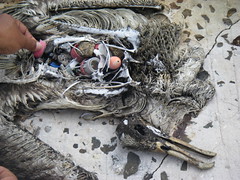 Click here for the slide show
Click here for the slide show
A Dutch study in the North Sea of fulmar seabirds concluded 95 per cent of the birds had plastic in their stomachs. More than 1600 pieces were found in the stomach of one bird in Belgium.
Since his first encounter with the gyre in 1997, Moore created the Algalita Marine Research Foundation to help study the problem. Canadian filmmaker Ian Connacher joined Moore last year to film the garbage patch for his documentary, I Am Plastic.
“The most menacing part is those little bits of plastic start looking like food for certain animals, or the filter feeders don’t have any choice, they just pick them up,” noted Connacher.
Perhaps an even bigger problem is hiding beneath the surface of the islands of garbage. Greenpeace reports that about 70 per cent of the plastic that makes it to the ocean sinks to the bottom, where it then smothers marine life on the ocean floor. Dutch scientists have found 600,000 tons of discarded plastic on the bottom of the North Sea alone.
A study by the Japanese geochemist Hideshige Takada and his colleagues at Tokyo University in 2001 found that plastic polymers soak up the resilient poisons such as DDT and polychlorinated biphenyls. The researchers found that non-water-soluble toxic chemicals can be found in plastic in levels as high as a million times their concentration in water. As small pieces of plastic are mistaken for fish eggs and other food by marine life, these toxins end up at the dinner table. But even without the extra toxins, eating plastic is hazardous to health.
see http://www.dailygalaxy.com/my_weblog/2007/12/are-there-reall.html
Find plastic free products with the >>>A-Z<<< plastic free index

